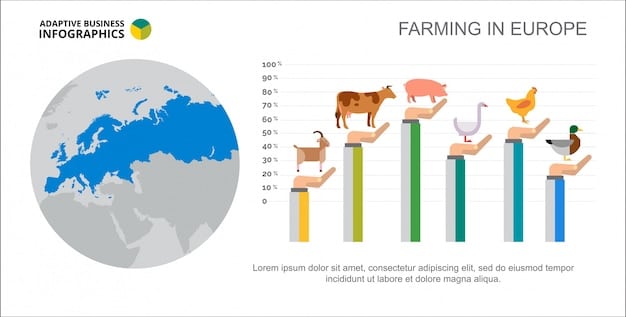Trade Agreements Impact on US Agricultural Exports in 2025

Understanding the impact of new trade agreements on US agricultural exports in 2025 involves analyzing potential market expansion, tariff reductions, and non-tariff barriers, which can significantly influence the competitiveness and volume of US agricultural products sold abroad.
The landscape of US agricultural exports is constantly evolving, and 2025 is poised to be a pivotal year. Understanding the impact of new trade agreements on US agricultural exports in 2025 requires a close examination of emerging policies and their potential effects on the nation’s agricultural sector.
The Current State of US Agricultural Exports
Before diving into the potential impacts of new trade agreements, it’s crucial to understand the current landscape of US agricultural exports. This sector plays a vital role in the US economy, contributing significantly to both employment and GDP.
Key commodities such as soybeans, corn, beef, and dairy products form the backbone of US agricultural exports. These products are shipped to various corners of the globe, with major markets including China, Canada, Mexico, and Japan.
Major Export Markets
Understanding the geographical distribution of US agricultural exports is critical. Here are some key destinations:
- China: A major importer of US soybeans and corn, driven by its large population and growing demand for animal feed.
- Canada and Mexico: As partners in the USMCA agreement, these countries are significant markets for a wide range of US agricultural products, including grains, meats, and fresh produce.
- Japan: A long-standing trade partner, Japan imports substantial quantities of US beef, pork, and wheat.
The dynamics of these relationships, influenced by trade agreements and geopolitical factors, directly affect the volume and value of US agricultural exports.

In summary, the current state of US agricultural exports is characterized by a dependence on a few key commodities and markets, making it vulnerable to shifts in trade policy and global demand.
Analyzing Existing Trade Agreements
Existing trade agreements serve as the foundation upon which future trade policies will be built. Understanding the successes and shortcomings of these agreements is crucial for predicting the impact of new ones.
The USMCA (United States-Mexico-Canada Agreement) and the CPTPP (Comprehensive and Progressive Agreement for Trans-Pacific Partnership) are two of the most significant agreements influencing US agricultural trade.
USMCA: A North American Framework
The USMCA has reshaped trade relations between the US, Mexico, and Canada. Some key aspects of this agreement include:
- Tariff Elimination: Elimination of tariffs on many agricultural goods, facilitating smoother trade flows within North America.
- Increased Market Access: Provisions for increased market access for US dairy and poultry products in Canada.
- Dispute Resolution Mechanisms: Strengthened mechanisms for resolving trade disputes, providing a more stable and predictable trading environment.
While the USMCA has generally been positive for US agricultural exports, challenges remain, particularly in addressing non-tariff barriers and sanitary and phytosanitary regulations.
CPTPP: Opportunities and Challenges
The CPTPP, despite the US withdrawal in 2017, continues to influence global trade dynamics. The absence of the US in the CPTPP presents both challenges and opportunities:
- Increased Competition: US exporters face increased competition from CPTPP member countries, particularly in markets like Japan and Vietnam.
- Potential for Re-engagement: The possibility of the US rejoining the CPTPP or negotiating bilateral agreements with member countries remains open.
- Focus on Other Markets: The US has focused on bilateral agreements with countries outside the CPTPP to diversify its export markets.
Existing trade agreements provide valuable lessons for shaping future trade policy, highlighting the importance of tariff reduction, market access, and dispute resolution mechanisms.

Overall, analyzing these agreements provides a nuanced understanding of the complexities of international trade and the importance of strategic trade policy.
Potential New Trade Agreements in 2025
Looking ahead to 2025, several potential new trade agreements could significantly impact US agricultural exports. These agreements represent opportunities for market expansion and enhanced trade relations.
Potential agreements with the United Kingdom, the European Union, and various Asian countries are currently under discussion, each offering unique prospects and challenges.
Trade Agreement with the United Kingdom
Following Brexit, the UK is seeking to establish new trade relationships with countries around the world. A trade agreement with the US could provide significant benefits for US agriculture:
- Market Access: Increased access to the UK market for US beef, poultry, and other agricultural products.
- Regulatory Alignment: Opportunities to align regulatory standards and reduce non-tariff barriers.
- Geopolitical Benefits: Strengthened economic and political ties between the US and the UK.
However, negotiations may be complex, particularly in addressing issues related to food safety standards and agricultural subsidies.
Trade Agreement with the European Union
A comprehensive trade agreement with the EU remains a significant long-term goal. Such an agreement could transform the landscape of US agricultural exports:
- Large Market: Access to the EU’s large and affluent consumer market.
- High Standards: Opportunities to promote US agricultural standards and practices.
- Economic Integration: Deeper economic integration between the US and the EU.
However, significant hurdles remain, including differences in regulatory approaches and concerns over agricultural subsidies.
These potential trade agreements underscore the dynamic nature of global trade and the importance of strategic engagement with key trading partners.
Impact on Specific Agricultural Sectors
New trade agreements are not created equal; their impact varies across different agricultural sectors. Some sectors may experience significant growth, while others may face new challenges.
The beef, dairy, and grains sectors are likely to be among the most affected by new trade agreements. Understanding these impacts requires a sector-specific analysis.
Beef Sector
The US beef sector stands to gain significantly from new trade agreements. Here’s how:
- Increased Demand: Access to new markets could drive increased demand for US beef.
- Higher Prices: Reduced tariffs and non-tariff barriers could lead to higher prices for US beef exports.
- Competitive Advantage: Improved market access could enhance the competitiveness of US beef producers.
However, challenges remain in meeting the specific quality and safety standards of different markets.
Dairy Sector
The dairy sector could also benefit from new trade agreements, particularly in markets with growing demand for dairy products:
- Export Opportunities: Increased export opportunities for US cheese, milk powder, and other dairy products.
- Market Diversification: Diversification of export markets, reducing reliance on a few key destinations.
- Value-Added Products: Opportunities to export high-value, processed dairy products.
However, competition from other dairy-exporting countries could pose a challenge.
A sector-specific analysis is essential for understanding the nuanced impacts of new trade agreements and for developing strategies to maximize benefits and mitigate risks.
Challenges and Risks
While new trade agreements offer significant opportunities, they also present challenges and risks that must be carefully managed. These challenges range from political instability to currency fluctuations.
Political instability in key export markets, currency fluctuations, and non-tariff barriers are among the most significant risks facing US agricultural exporters.
Political Instability
Political instability in key export markets can disrupt trade flows and create uncertainty for US exporters:
- Trade Disruptions: Political unrest or conflict can lead to trade disruptions and reduced demand.
- Policy Changes: Changes in government can result in shifts in trade policy.
- Investment Risks: Political instability can deter investment in export-related infrastructure.
Diversifying export markets and developing robust risk management strategies can help mitigate these risks.
Currency Fluctuations
Currency fluctuations can also impact the competitiveness of US agricultural exports. A strong dollar, for example, can make US products more expensive for foreign buyers:
- Price Competitiveness: Currency fluctuations can affect the price competitiveness of US exports.
- Hedging Strategies: Exporters may need to employ hedging strategies to manage currency risk.
- Market Volatility: Currency volatility can create uncertainty and make it difficult to plan for the future.
Monitoring currency trends and implementing appropriate risk management strategies are essential for mitigating these risks.
Addressing these challenges requires a proactive approach, including careful risk assessment, market diversification, and strategic partnerships.
Policy Recommendations for Maximizing Benefits
To maximize the benefits of new trade agreements, the US government and agricultural industry must implement strategic policies. These policies should focus on enhancing competitiveness, promoting sustainable practices, and investing in infrastructure.
Investing in infrastructure, promoting sustainable practices, and enhancing the competitiveness of US agricultural products are key policy priorities.
Investing in Infrastructure
Investing in transportation and logistics infrastructure is crucial for ensuring the efficient movement of agricultural products:
- Port Modernization: Modernizing ports and improving shipping infrastructure.
- Transportation Networks: Upgrading roads and railways to facilitate the transport of goods.
- Storage Facilities: Expanding and modernizing storage facilities to preserve the quality of agricultural products.
These investments can reduce transportation costs and improve the competitiveness of US agricultural exports.
Promoting Sustainable Practices
Promoting sustainable agricultural practices can enhance the long-term viability of the US agricultural sector and increase its appeal to environmentally conscious consumers:
- Environmental Stewardship: Incentivizing practices that reduce environmental impact.
- Organic Production: Supporting the growth of organic agriculture.
- Certification Programs: Developing and promoting certification programs that verify sustainable practices.
These initiatives can enhance the reputation of US agricultural products and increase their market value.
By implementing these policy recommendations, the US can ensure that its agricultural sector is well-positioned to capitalize on the opportunities presented by new trade agreements.
| Key Point | Brief Description |
|---|---|
| 🌍 New Trade Agreements | Potential deals with UK, EU, and Asia can boost exports. |
| 🐄 Sector Impact | Beef, dairy, and grains sectors stand to benefit significantly. |
| ⚠️ Potential Risks | Political instability and currency fluctuations pose challenges. |
| 🌱 Policy Priorities | Invest in infrastructure and promote sustainable practices. |
Frequently Asked Questions
▼
The main agricultural products the US exports include soybeans, corn, beef, dairy products, and wheat. These commodities are in high demand worldwide and drive a significant portion of US agricultural trade.
▼
The USMCA reduces tariffs and increases market access in Canada and Mexico for US agricultural products. It provides a more stable environment for trade within North America, benefiting sectors like dairy and poultry.
▼
US agricultural exporters face challenges such as political instability in key markets, currency fluctuations, and non-tariff barriers like sanitary and phytosanitary regulations. These can disrupt trade and reduce competitiveness.
▼
The US can enhance its agricultural exports by investing in infrastructure, promoting sustainable practices, and enhancing the competitiveness of US agricultural products. Strategic policies can maximize the benefits of trade agreements.
▼
Trade agreements reduce trade barriers like tariffs and quotas, making it easier for US agricultural products to access foreign markets. They also provide a framework for resolving trade disputes and ensuring fair competition.
Conclusion
Understanding the impact of new trade agreements on US agricultural exports in 2025 requires a comprehensive analysis of current agreements, potential new deals, and the challenges and risks involved. By implementing strategic policies and investing in infrastructure, the US can maximize the benefits of these agreements and ensure the long-term success of its agricultural sector.





